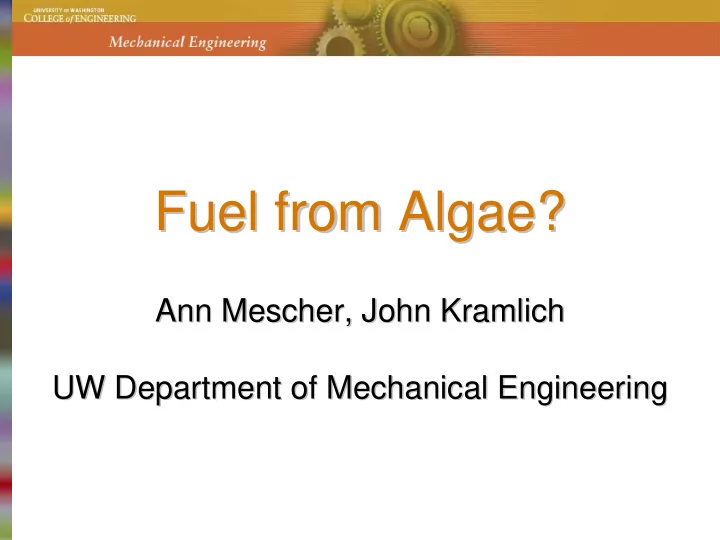

Fuel from Algae? Fuel from Algae? Ann Mescher Mescher, John , John Kramlich Kramlich Ann UW Department of Mechanical Engineering UW Department of Mechanical Engineering
Transportation fuel market and emissions • U.S. Transportation: 180 billion gallons fuel per year. • Europe: 5.75% bio-diesel content by 2010, 10% by 2020. • Majority of industrialized world signed Kyoto Treaty to reduce greenhouse gas emissions. • President elect Obama sets goal of 1990 level emissions by 2020.
“The world’s got a pretty simple choice here. It’s between George W. Bush and grandchildren.” Bob Brown, Australian Senator, calling for a U.S. oil boycott because of George Bush’s refusal to sign the Kyoto climate change treaty.
Life-cycle CO 2 emissions
Food Fuel Energy Food Fuel Energy Nexus Nexus Water Water
Why Algae in Washington?
Cost of Algae Production 1982 - Benemann et al . created one of the least expensive production systems – using open ponds - the cost of algae produced was around 40 to 50 cents/kg in today’s dollars. 1988 - Tapie & Bernard used tubular bioreactors at a cost of $9 to $10/kg. 1992 - Coutteau & Sorgeloos observed a cost > $600/kg using plastic bags and other closed systems.
Value of Algal Oil • At 30% lipid content, 10 kg algae yields 3 kg oil ~ 1 gallon • For comparison, petro-oil value ~ $3 per gallon • Value of dry algae ~ $3 / 10 kg = 30 cents per kilogram
Some benchmarking
Spirulina Harvest densities 1:3000 This could be lots of work!
Electric costs for centrifuging: $2.60 per kg ? Ugh! Drying? Filtering?
Critical Challenges • Algal strains for high-level production – Fast growth – High oil production – Resistance to contamination • Cultivation facility design – High vs. low intensity – Water sources – Nutrient sources – Harvesting • Conversion to fuel and other products
Oil extraction
In our lab: Hexane solvent extraction using Soxhlet apparatus
Cost for Supercritical Extraction? • Comparison of cost for hexane solvent extraction versus supercritical CO 2 • Supercritical CO 2 less expensive but at $2 per lb or about $5 per kilogram Ugh!
Soxhlet apparatus periodically immerses the sample in solvent during each solvent exchange, or “reflux,” which allows us to extract varying mass fractions of the sample's total lipid content. Small aliquots of combined solvent and extracted lipid are removed, after a specified number of solvent refluxes. The number of solvent refluxes is directly proportional to the period of time over which the algal sample is immersed in the solvent. As the number of refluxes increases, so also increases the extracted mass percentage of the alga’s total lipid content.
Oil Structure H O H C O C CH CH CH CH CH CH CH 2 2 2 2 2 2 3 O H C O C CH CH CH CH CH CH CH 2 2 2 2 2 2 3 O H C O C CH CH CH CH CH CH CH 2 2 2 2 2 2 3 H Fats are glycerin molecules with carboxylic acid chains attached Length can be 8-22 carbons. Can be unsaturated. Goal for biojet is 8-16, while algae produces through 22. Raw fats not suitable for jet fuel (too viscous, etc.)
Refined by Transesterfication H H O O H C O C R 1 CH O C R 1 H C OH 3 O O + + H C O C R 2 CH 3 OH CH O C R 2 H C OH 3 O O H C O C R 3 CH O C R 3 H C OH 3 H H Fat treated with alcohol and acid or base catalyst Produces two phases: biofuel and glycerin (containing wastes)
Transesterification procedure is an adaptation of AOCS method Ce-89b. Transesterified product (left) and glycerol / salt solution (right).
Capillary column of Gas Chromatography System
Machine: PerkinElmer Autosystem XL with capillary injector and FID using a Supelco fused-silica SPB-PUFA column (30m length by 0.32mm i.d., 0.2µm film). Temperature program: 240ºC injection in a PerkinElmer capillary injector with a 30 second splitless period followed by 50:1 split. Initial 80ºC column temperature with a 1 minute hold, followed by a ramp of 10ºC per minute to 210ºC at 14 minutes, with a hold at 210ºC until 40 minutes. FID at 260ºC.
Boeing Sponsored Project • Interest in Biojet fuel • Study fuel oil yield and composition (molecular weight and distribution) depending on processing conditions and methods.
Fuel Properties Depend on Chain Length • Viscosity, surface tension ---> Atomization • Freezing temperature --> Wing tanks • Flammability limits, quenching limits, flame speed --> Compatibility with existing combustors
35% 30% 25% % of Total FAME's 20% 15% 10% 5% 0% C1 4:0 C1 6:0 C1 6:1 C1 6:2 C1 8:0 C1 8:1 cis C1 8:2cis C1 8:3n3 C1 8:4 C20:0 C20:2n6 C20:3n3 C20:4 C20:5 Component Relative Lipid Content, % mass basis
50.00% 45.00% 40.00% 35.00% % of dry w e ight 30.00% 25.00% 20.00% 15.00% 10.00% 5.00% 0.00% Reflux 2 Reflux 4 Reflux 6 Reflux 8 Reflux 16 Reflux 1 Reflux 3 Reflux 5 Reflux 7 Reflux 12 Reflux 20 . Extracted FAME mass (percentage of dry algal mass) as a function of reflux number
Chromatograms of SA37 standard (above) and transesterified lipids (below).
For us, it’s all about Energy Costs of Processing! • Dewatering • Extraction • Transesterification or ? – Alcohol needed – Mechanical work or heating needed – Glycerol byproduct? • Fuel cleaning/catalyst removal • Goal: Get needed composition with economically optimum yields and low energy costs
Recommend
More recommend